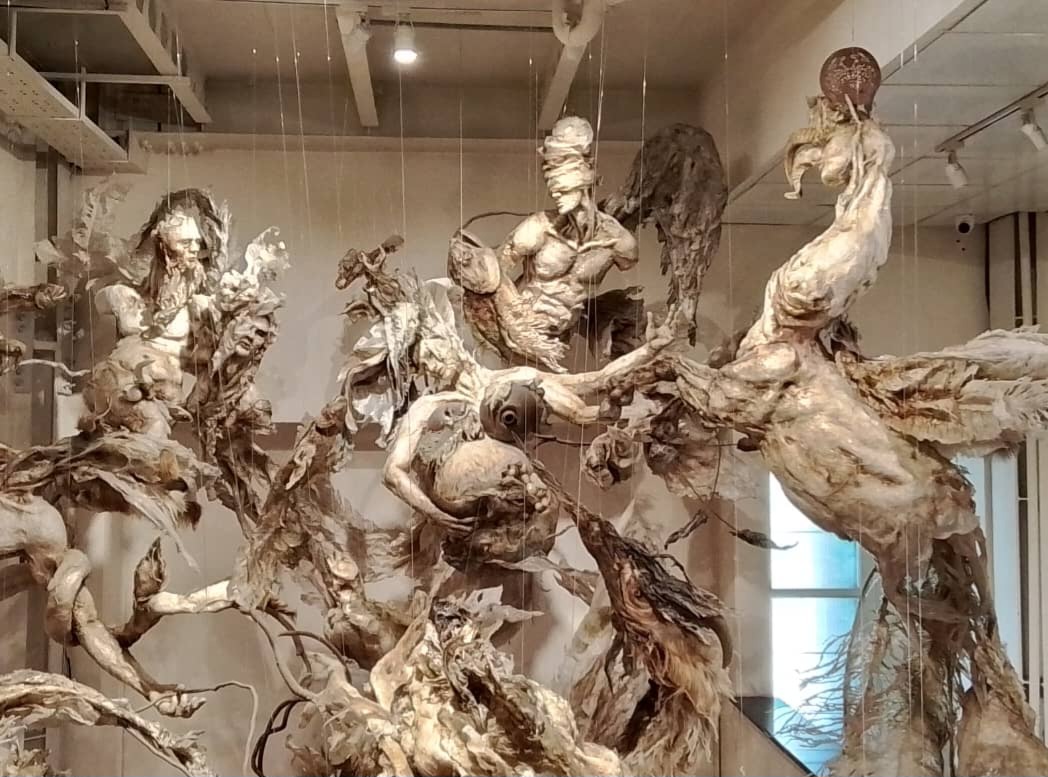
Vohu-Manah (Vohuman) in Bundahishn by Elham Fallahi :The Wounded Guardian of Waters, Raha Gallery Collection
The sculpture Vohuman occupies the uppermost position in the vast and astonishing installation Bundahishn—placed precisely above the figure of Ahura Mazda. It is not merely one among the 82 sculptures constituting the work; it bears a distinct philosophical reading: a figure with closed eyes, holding a fish to its chest. Fallahi’s Vohuman is the wounded guardian of life—an entity that, in a chaotic world, brings forth good thoughts not by force, but through an embrace.
ArtDayMe :Raha Gallery Collection founded and directed by engineer Mohammadreza Ghaemmaghami has, for more than two decades, operated with a focus on elevating regional art, maintaining a diverse selection of modernist and contemporary masterpieces by Iranian and Arab artists.
Among these works stands the large-scale installation Bundahishn by Elham Fallahi—a work executed in mixed media using recycled and abandoned materials found in the environment, especially plastic (nylon). The installation comprises six large human-like figures, 76 sculptures of varying sizes, and connector components, extending across a structure measuring 6 × 6 × 4 meters. Produced by Raha Gallery Collection of the Middle East, it was completed in 2019 following two years and six months of creation.

Among the six monumental figures of this installation, the focus of this text is Vohuman.
Vohuman is one of the most prominent Amesha Spentas in Zoroastrianism and is regarded in mythology as the embodiment of Good Thought, purity of mind, and affinity with the animal realm.
In Fallahi’s sculpture, Vohuman holds a fish to its chest, eyes closed.
The fish—symbol of life and fertility—today also stands as an emblem of environmental crisis.
Alongside the other Amesha Spentas, Vohuman aids Ahura Mazda in purifying the world from corruption and evil, guiding it toward light and truth.
Vohuman is not only the representative of good thought; he also assumes the responsibility of guarding waters and lakes. Water, in Zoroastrian teachings, is recognized as a sacred, vital element of life.
More specifically, Vohuman is entrusted with preserving lakes and the purity of their waters—waters that, in ancient times, were not only essential for drinking but for cleansing and spiritual salvation.

Elham Fallahi envisions Vohuman in a suspended, semi-human form, eyes closed—an allusion to inner contemplation, mystical insight, or transcendent intuition.
Within the Raha Gallery Collection, Vohuman in Bundahishn bears worn—almost tattered—wings and an organic, yet wounded texture. A kind of eroded angelic presence: a passage from eternal goodness to wounded goodness—a sacred force becoming fragile. His form is a stark warning that environmental pollution has inflicted profound damage upon aquatic life and, consequently, upon human existence.

Thus, the overall form of Bundahishn and Vohuman holds a delicate balance between vitality and collapse—an entity poised between becoming and resurrection.
The use of recycled, abandoned materials directly reinforces this warning, serving both as critique of consumerism and call to reawaken spirituality in a polluted world.
Fallahi’s Vohuman carries layered meanings: a rereading of myth; a bridge between Amesha Spentas and contemporary urgency; a summoning of Zoroastrian cosmology into present time; a merging of care and decay; a renewed interpretation of Eastern spirituality under the shadow of ecological catastrophe.
The work neither glorifies the past nor depicts the future, but rather forms a dialogue between creation, disintegration, and hope.

_ Position within the Bundahishn Installation
Elham Fallahi’s Bundahishn installation in the Raha Gallery Middle East Collection—an interpretation of the creation narrative—presents Vohuman as the bearer of Good Thought. Yet this time, in a world engulfed by crisis, Good Thought must cradle “life” amid chaos.
This interpretive shift transforms the work from traditional mythic reconstruction into a post-mythic reading.
Fallahi’s Vohuman becomes the wounded guardian of life—an entity that, in a fractured world, brings forth good thought not through force, but through an embrace.
In Zoroastrian teachings, Vohuman symbolizes noble wisdom, committed to fostering goodness, righteousness, and purity in the world.
He is the angel of wisdom and good thoughts, guiding people toward conscious and righteous action.
Vohuman may be regarded as a symbol of purity and clarity: pure waters—central to Zoroastrian belief—are considered sources of proper thought, healthy living, and spiritual integrity. Thus, the protection of waters and prevention of pollution are essential spiritual duties, fulfilled through Good Thought (Vohuman) which directs individuals toward ethical behavior.

_ The Market Value of Works by Elham Fallahi
Notably, the works of Elham Fallahi are held in important art collections across the United States, Europe, and Iran, including:
Raha Gallery Iran–Dubai Collection;
Mortezavi Foundation Collection Iran–USA;
Didi Gallery Museum Iran;
Oak Tree Collection – Levy Collection USA;
City Park Collection USA;
Marble Gallery USA;
Rira Gallery Dubai;
and several private collections in Iran, France, Australia, Canada, the United States, and China.
The market value of Fallahi’s work has seen remarkable upward growth over recent years.
Her very small pieces—such as a life-scale rose—have sold for USD 2,500, while her large multi-figure ensembles have sold for USD 240,000 through the artist’s studio, galleries, and expos.
Fallahi’s works have appeared in auctions twice:
At the Tehran Auction (2019), her work Rakhsh and Homay—created in 2017 using the same recycled materials, measuring 120 × 100 × 150 cm—sold for four times its base price: 240 million IRR (approx. USD 22,000 at the time).
A smaller sculpture titled Horse Bust, measuring approximately 50–40–30 cm, sold for USD 10,000 at MAP Auction (USA), 2021.
Bundahishn has received substantial attention within the art community, and numerous museums and biennials have requested to exhibit the work.
The installation Bundahishn by Elham Fallahi belongs to the Raha Gallery Middle East Collection.

LEAVE A RELPY